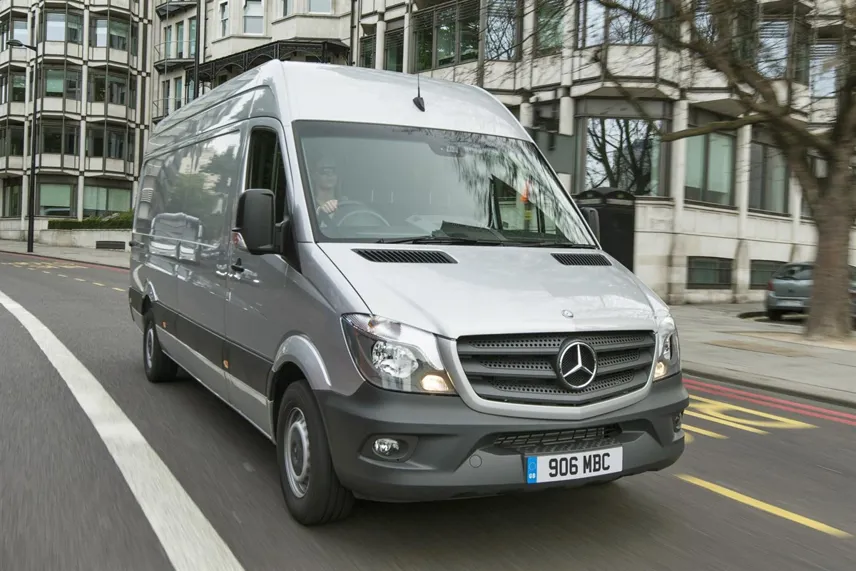Review
Legislation has been passed dictating that all new vans sold after September 1, 2015, must comply to Euro 6 emissions standards. After that date, new vans will emit fewer particulate and NOx gases, but they will also cost more to buy.
This is because as emissions criteria become ever tighter, the van manufacturers need to pour millions of pounds into R&D, which customers end up paying for.
At present, only two vans on the road comply with Euro 6 – certain variants of the new Ford Transit which are due to go on sale soon and the van on test here, the Mercedes-Benz Sprinter Euro 6, which was launched last year.
What are the benefits and drawbacks of Euro 6? For starters, this van costs £1,120 more than its Euro 5 cousin and thanks to the tank for Adblue, which it needs to meet the Euro 6 standards, it loses 35kg on payload. Adblue will cost about 20p per 100 miles, which means a £160 outlay over an 80,000-mile lifecycle.
This van returns 35.8mpg on the official combined cycle as opposed to 32.1mpg for the Euro 5 model. At current diesel prices, this is a saving of £1,604 on fuel over the van’s life – a net saving of £324.
here are the lower emissions to consider too – CO2 is down from 227g/km to 206g/km, NOx is reduced by 80% and particulates are cut by 50%.
The new Sprinter is about much more than just a tank of Adblue though. This van leaves the opposition standing in terms of safety systems.
Before this update, it was already the safest van on the roads, with standard features such as adaptive electronic stability control, ABS brakes, and acceleration skid control.
Our test model also had Crosswind Assist, Collision Prevention Assist, Blind Spot Assist, Lane Keeping Assist and High Beam Assist, adding £1,090 to the list price.
Options of today tend to be standard fixtures of the future, so we can assume that in near future, most other van manufacturers will be offering this level of sophistication.
Behind the wheel
The first thing to note about this van is that the driver won’t feel any difference between Euro 5 and Euro 6 engines.
This technology is all about emissions and doesn’t affect engine running, ride or handling. But whatever Euro standards the Sprinter adheres to, it’s a mighty performer and deservedly holds the Fleet Van van of the year 2013 award.
It’s a big step up into the cab, and the elevated driving position gives a great view of the road ahead.
The cab itself is bigger than that of the new Ford Transit, giving it a much airier ambience.
The driver’s seat is massive and comfortable, fully supporting every area of the back. We managed a 200-mile trip with no lumbar twinges.
Despite its size, the Sprinter handles like a big car once out on the road, although reversing and parking can prove tricky.
We could have done with reversing sensors for such a large vehicle, but they weren’t included on our test model.
In the back, there’s headroom aplenty for six-footers, a wipe clean floor, full ply-lining and a total of 12 load lashing eyes.
A nice touch, too, is a handy grab rail near the rear doors for drivers to swing themselves up into the load area from the ground.
Trevor Gehlcken, April 2014
Author:
Fleet News
Specs
| Manufacturer | Mercedes-Benz |
| Model | Sprinter Light Commercial |
| Specification | Volkswagen Tiguan Estate Special Edition 2.0 TDI R-Line Edition 5dr DSG |
| Model Year | 2022.00 |
| Annual VED (Road tax) | £255 |
| BIK List Price | £38,895 |
| CO2 | 150g/km |
| Insurance Group | N/A |
| CC | 1,968 |
| Fuel Type | |
| Vehicle Type | Medium SUV |
| Luggage capacity (Seats up) | 615litres |
Running Costs
| P11D | £38,895 |
| Cost per mile | 53.35ppm |
| Residual value | £18,025 |
| Insurance group | N/A |
| Fuel Type | |
| Cost per mile | 138.04ppm |
| Fuel | 13.47ppm |
| Depreciation | 123.75ppm |
| Service maintenance and repair | 0.82ppm |
Rivals
Info at a glance
-
P11D Price
£38,895
-
MPG
49.6 -
CO2 Emissions
150g/km -
Payload
619kg -
Load Volume
N/A -
Load Width
1,859mm -
Load Length
4,511mm





 Diesel
Diesel












